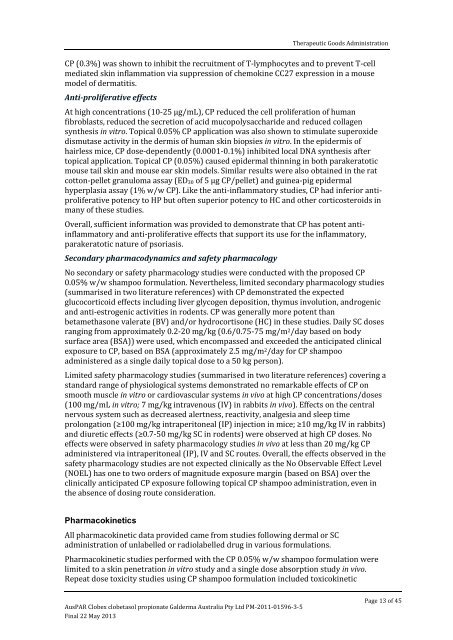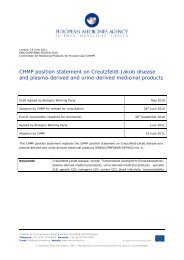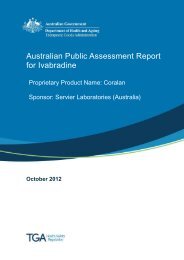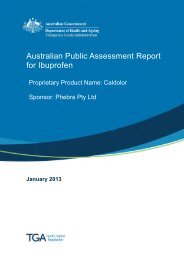AusPAR: Clobetasol propionate - Therapeutic Goods Administration
AusPAR: Clobetasol propionate - Therapeutic Goods Administration
AusPAR: Clobetasol propionate - Therapeutic Goods Administration
You also want an ePaper? Increase the reach of your titles
YUMPU automatically turns print PDFs into web optimized ePapers that Google loves.
<strong>Therapeutic</strong> <strong>Goods</strong> <strong>Administration</strong>CP (0.3%) was shown to inhibit the recruitment of T-lymphocytes and to prevent T-cellmediated skin inflammation via suppression of chemokine CC27 expression in a mousemodel of dermatitis.Anti-proliferative effectsAt high concentrations (10-25 µg/mL), CP reduced the cell proliferation of humanfibroblasts, reduced the secretion of acid mucopolysaccharide and reduced collagensynthesis in vitro. Topical 0.05% CP application was also shown to stimulate superoxidedismutase activity in the dermis of human skin biopsies in vitro. In the epidermis ofhairless mice, CP dose-dependently (0.0001-0.1%) inhibited local DNA synthesis aftertopical application. Topical CP (0.05%) caused epidermal thinning in both parakeratoticmouse tail skin and mouse ear skin models. Similar results were also obtained in the ratcotton-pellet granuloma assay (ED 30 of 5 µg CP/pellet) and guinea-pig epidermalhyperplasia assay (1% w/w CP). Like the anti-inflammatory studies, CP had inferior antiproliferativepotency to HP but often superior potency to HC and other corticosteroids inmany of these studies.Overall, sufficient information was provided to demonstrate that CP has potent antiinflammatoryand anti-proliferative effects that support its use for the inflammatory,parakeratotic nature of psoriasis.Secondary pharmacodynamics and safety pharmacologyNo secondary or safety pharmacology studies were conducted with the proposed CP0.05% w/w shampoo formulation. Nevertheless, limited secondary pharmacology studies(summarised in two literature references) with CP demonstrated the expectedglucocorticoid effects including liver glycogen deposition, thymus involution, androgenicand anti-estrogenic activities in rodents. CP was generally more potent thanbetamethasone valerate (BV) and/or hydrocortisone (HC) in these studies. Daily SC dosesranging from approximately 0.2-20 mg/kg (0.6/0.75-75 mg/m 2 /day based on bodysurface area (BSA)) were used, which encompassed and exceeded the anticipated clinicalexposure to CP, based on BSA (approximately 2.5 mg/m 2 /day for CP shampooadministered as a single daily topical dose to a 50 kg person).Limited safety pharmacology studies (summarised in two literature references) covering astandard range of physiological systems demonstrated no remarkable effects of CP onsmooth muscle in vitro or cardiovascular systems in vivo at high CP concentrations/doses(100 mg/mL in vitro; 7 mg/kg intravenous (IV) in rabbits in vivo). Effects on the centralnervous system such as decreased alertness, reactivity, analgesia and sleep timeprolongation (≥100 mg/kg intraperitoneal (IP) injection in mice; ≥10 mg/kg IV in rabbits)and diuretic effects (≥0.7-50 mg/kg SC in rodents) were observed at high CP doses. Noeffects were observed in safety pharmacology studies in vivo at less than 20 mg/kg CPadministered via intraperitoneal (IP), IV and SC routes. Overall, the effects observed in thesafety pharmacology studies are not expected clinically as the No Observable Effect Level(NOEL) has one to two orders of magnitude exposure margin (based on BSA) over theclinically anticipated CP exposure following topical CP shampoo administration, even inthe absence of dosing route consideration.PharmacokineticsAll pharmacokinetic data provided came from studies following dermal or SCadministration of unlabelled or radiolabelled drug in various formulations.Pharmacokinetic studies performed with the CP 0.05% w/w shampoo formulation werelimited to a skin penetration in vitro study and a single dose absorption study in vivo.Repeat dose toxicity studies using CP shampoo formulation included toxicokinetic<strong>AusPAR</strong> Clobex clobetasol <strong>propionate</strong> Galderma Australia Pty Ltd PM-2011-01596-3-5Final 22 May 2013Page 13 of 45
















